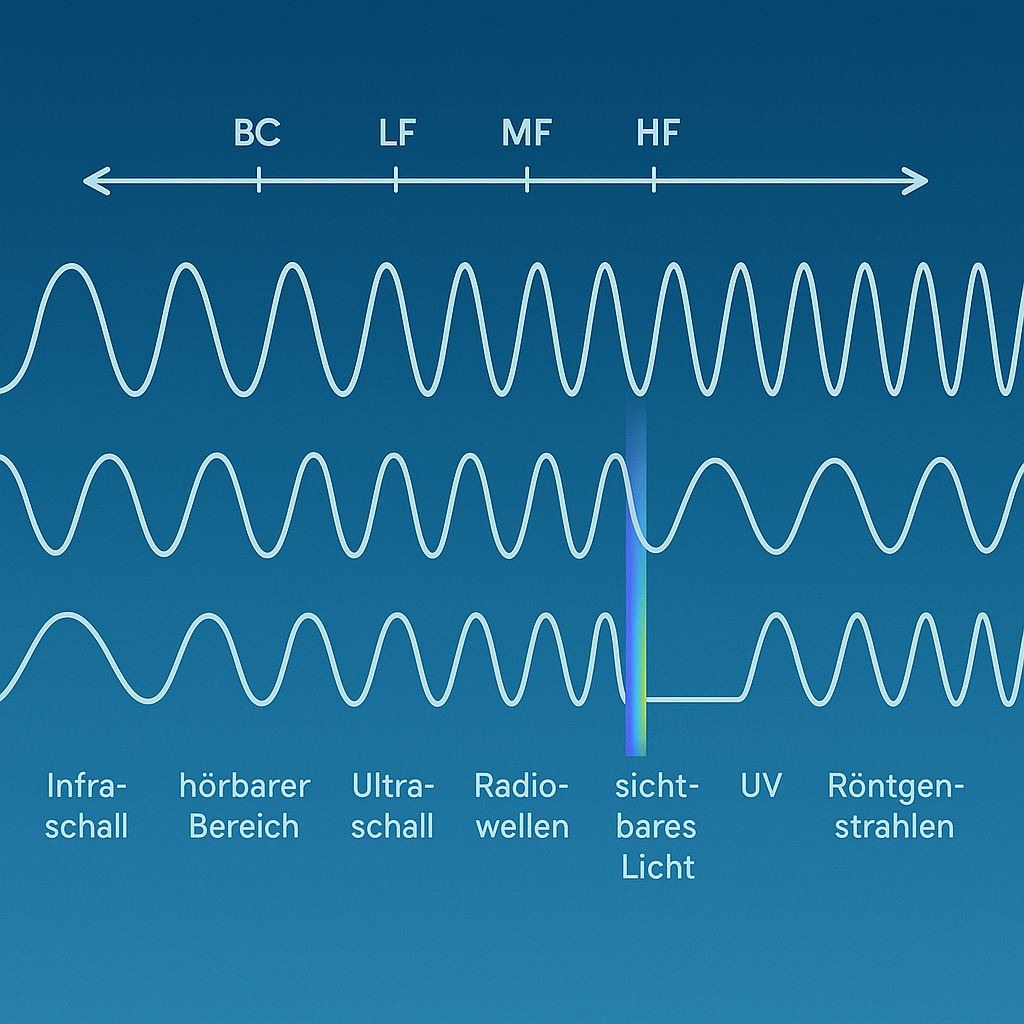
The frequency spectra - from infrasound to gamma radiation
Teaser: Frequency therapy uses vibrations - from infrasound to light. Learn about the scientific basis of frequency spectra.
Introduction
We are constantly surrounded by frequencies - they form the foundation of our lives and the entire physical world. Vibrations and waves are present both in acoustics and in the electromagnetic range. Whether audible sound, visible light or high-energy radiation, each frequency spectrum has its own properties, effects and areas of application. In this article, we look at the most important frequency ranges in detail - scientifically based and in relation to frequency therapy.
1. Infrasound (below 20 Hz)
Infrasound refers to vibrations below 20 Hz. These low frequencies are not audible to the human ear, but can be perceived physically, for example through vibrations. In nature, they are caused by earthquakes, volcanoes or strong weather phenomena, for example. Studies show that infrasound can have physiological effects, including on the nervous system. Very low frequencies are also used in frequency therapy to harmonise the organism.
2. Audible sound (20 Hz - 20 kHz)
The audible range comprises vibrations between 20 Hz and 20,000 Hz. This range is central to human perception as it includes music, speech and environmental sounds. Low frequencies (bass) often have a calming effect, while high frequencies (treble) have a stimulating effect. In therapy, this range is used in a targeted manner - for example through music therapy, solfeggio frequencies or targeted frequency impulses, which can also have an effect on emotional and physical levels. Research is being conducted into how sound frequencies influence cell communication, particularly in the area of diseases such as cancer.
3. Ultrasound (above 20 kHz)
Ultrasound frequencies above 20 kHz are inaudible to humans. They are used in medical technology (e.g. ultrasound imaging) and in therapy (e.g. promoting blood circulation, tissue regeneration). High-frequency oscillations are also used in frequency medicine to stimulate regulatory processes.
4. Radio waves (30 Hz - 300 MHz)
Radio waves are part of the electromagnetic spectrum and cover frequencies from 30 Hz to 300 MHz. They are used for broadcasting, communication and radar. In frequency therapy, it is interesting to note that radio waves can resonate with biological systems, as cells and tissue also emit electromagnetic frequencies.
5. Microwaves (300 MHz - 300 GHz)
Microwaves are high-frequency electromagnetic waves that are used in technology (e.g. WLAN, mobile phones, microwave ovens). Scientifically, their interaction with biological tissue is of great importance - especially thermal and non-thermal effects. Research into frequency therapy is investigating how specifically modulated microwaves can control biological processes.
6. Infrared (300 GHz - 400 THz)
Infrared radiation is perceived as heat. It is a central component of heat therapy and has a wide range of medical applications - from infrared lamps to whole-body heat treatment. Frequency therapy uses the infrared range to promote blood circulation, metabolism and immune defence. Hyperthermia, which works with infrared waves, is also being researched for cancer treatments.
7. Visible light (400 - 789 THz)
The visible spectrum ranges from violet light (~400 THz) to red light (~789 THz). This is the range perceived by the human eye. Each colour has its own energetic qualities, which are also used in colour therapy. Frequency therapy sees light as a vibrational carrier that interacts directly with the cells.
8. Ultraviolet (UV, 789 THz - 30 PHz)
Ultraviolet radiation has higher energy than visible light and can strongly influence biological processes. While UVA rays penetrate deep into the skin, UVB rays act superficially and promote vitamin D synthesis. UV radiation is used specifically in medicine, but must be dosed carefully due to possible cell damage.
9. X-rays (30 PHz - 30 EHz)
X-rays are high-energy electromagnetic waves that are used for medical imaging. They can penetrate deep into the tissue and provide important diagnostic information. In cancer medicine, radiation is also used therapeutically in certain doses.
10. Gamma radiation (over 30 EHz)
Gamma rays are the most energy-rich waves in the electromagnetic spectrum. They are produced during radioactive decay processes or in cosmic events. In oncology, they are used in radiotherapy to specifically destroy tumour cells.
Frequency therapy and the entire spectrum
Frequency therapy uses different frequency ranges to harmonise biological processes and support self-regulation. It is not about "a single frequency", but about resonance with the respective biological system. In the field of cancer research in particular, the question of how frequencies work at cell level and what therapeutic potential they can unfold is exciting.
Conclusion
From infrasound to gamma radiation - the frequency spectrum is a fascinating journey through the world of vibrations. Each frequency has its own specific properties and effects. In frequency therapy, understanding these spectra opens up new perspectives for holistic healing approaches. Frequencies are universal carriers of information - and therefore a key to health and consciousness.
Note: Frequency therapy is not recognised by conventional medicine and does not replace treatment by a doctor or alternative practitioner.
